How Is Ceramic Proppant Made?
Ceramic proppants are essential materials used in hydraulic fracturing, also known as fracking, a process used to extract natural gas and oil from deep underground. These small beads help keep fractures in the rock formations open, allowing the gas and oil to flow more easily to the surface. But have you ever wondered how ceramic proppants are made? In this article, we will explore the manufacturi
fast chargerss are essential materials used in hydraulic fracturing, also known as fracking, a process used to extract natural gas and oil from deep underground. These small beads help keep fractures in the rock formations open, allowing the gas and oil to flow more easily to the surface. But have you ever wondered how ceramic proppants are made? In this article, we will explore the manufacturing process of ceramic proppants.

Raw Materials
The main raw materials used in the production of ceramic proppants are bauxite, kaolin, and other clay minerals. These materials are finely ground to create a powder that will serve as the base for the proppants. Other additives such as silica sands and alumina are also mixed in to enhance the strength and durability of the final product.
Mixing and Forming
Once the raw materials are prepared, they are mixed together in precise proportions to achieve the desired properties of the ceramic proppants. The mixture is then formed into small spherical beads through a process called pelletizing. This involves the use of high-pressure equipment to compress the powder and shape it into the desired size and shape.
Drying
After the beads are formed, they are dried in specialized kilns to remove any moisture and ensure that they are ready for the next stage of the manufacturing process. The drying process is crucial to prevent cracking and ensure the strength of the ceramic proppants.
Firing
The dried ceramic proppants are then fired in kilns at high temperatures ranging from 1300°C to 1600°C. This process, known as sintering, helps to bond the particles together and create a strong, durable product. The precise temperature and duration of firing are critical factors that determine the quality of the ceramic proppants.
Cooling and Screening
Once the proppants have been fired, they are cooled gradually to room temperature to avoid thermal shock. The cooled beads are then screened to remove any oversized or undersized particles, ensuring that only high-quality ceramic proppants are packaged and shipped to customers.
Packaging
The final step in the manufacturing process involves packaging the ceramic proppants into bags or containers for distribution. The proppants are carefully packed to prevent breakage or damage during transportation.
In conclusion, the manufacturing process of ceramic proppants is a complex and precise operation that requires specialized equipment and expertise. The quality of the raw materials, the mixing proportions, and the firing temperatures all play a crucial role in determining the strength and durability of the final product. If you are in need of ceramic proppants for your fracking operations, make sure to contact a reputable supplier who can provide you with high-quality products that meet your specific requirements.
If you are looking for a reliable ceramic proppant supplier, contact us today to learn more about our products and services. We have a wide range of ceramic proppants available to meet the needs of your fracking operations. Contact us now to place your order and ensure a steady supply of high-quality proppants for your projects.